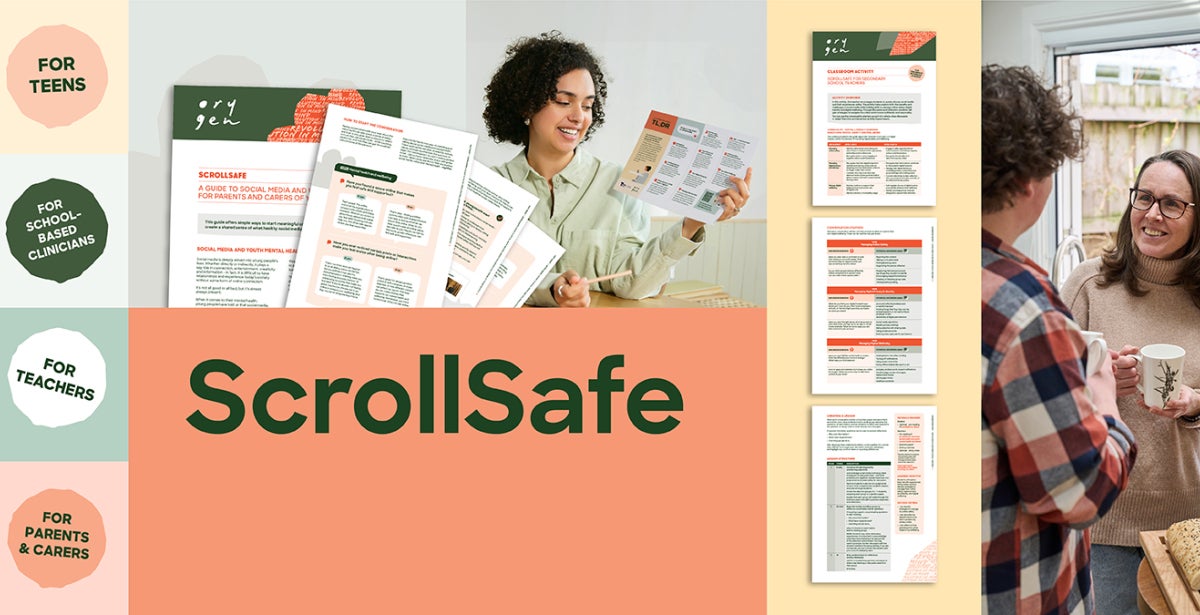
Teens are still on social media: Here’s how they can protect their wellbeing
With Australia’s social media age restriction on the horizon, conversations are growing about how it may affect young people’s mental health. But helping teens stay safe and well online takes more than just setting age limits.
Below, read insights from Zoe Nikakis, Senior Project Officer in Knowledge Translation at Orygen, and co-author of ScrollSafe.
Social media is a big part of everyone’s life – it provides a place for connection, creativity, and access to information. Many teens find a sense of community and belonging in the online world, connecting with like-minded people, sharing ideas, and feeling comfortable exploring their own identity.
However, social media doesn’t come without challenges. The same platforms that offer connection and support can also contribute to mental ill-health.
So, what can we do to support the wellbeing of teens online?
Social media age restrictions in Australia
To protect teens, the Australian Government has introduced world-first legislation that will age-restrict social media for young people under the age of 16 years old. Teens may feel relief about the age restriction, taking away the social pressure of being online. Others may feel anxious or even lose their closest networks and social connections.
Regardless of how they feel about it, teens will still be accessing online spaces. And what about the teens who are already 16 or older and are actively engaged online?
Social media isn’t going anywhere: What it means for teen mental health
Young people will always feel a desire to connect and belong, and a lot of this happens online. Whether it’s for schoolwork, or through messaging apps, gaming, or even social media itself, young people will still be navigating online spaces.
Restrictions alone aren’t enough to protect young people. It’s just as important to help them develop skills to use social media in a balanced and confident way. Just like alcohol and drug education, building digital literacy and awareness early gives teens the tools to navigate online spaces safely. This becomes especially important when they turn 16 and can join social media legally. Developing these skills helps teens notice when social media is supporting their wellbeing, and when it might be taking a toll.
What we know about social media and teen mental health
There is increasing evidence linking high social media use with poor mental health outcomes. Australian research indicates that almost 40% of young people use social media three or more hours per day. These young people report high levels of distress and feel less in control over their lives.
However, the research also tells us that social media use is not all bad. Moderate users (1-3 hours per day) can experience similar or even better wellbeing outcomes to low users. Moderate users have reported lower levels of distress and higher feelings of life control. This suggests that when it comes to social media, moderation is key!
Ten wellbeing tips for online teens
Teens can become “mindful” social media users – using social media with care, thought, and in balanced ways. Orygen’s ScrollSafe suggests ten tips for teens to stay well online:
- Check in with yourself: Notice how social media makes you feel and when it’s time to take a break.
- Find your balance: Use social media to add to your life, not drain it.
- Spot your triggers: Track strong reactions and learn what content affects your mood.
- Be intentional: Think before posting, scroll with purpose, and give yourself permission to disconnect.
- Curate your feed: Follow accounts you enjoy and mute, unfollow or block ones that you don’t.
- Protect your digital footprint: Update privacy settings, leave old group chats, and keep your online identity true to who you are today.
- Keep it real: Post and interact online the same way you would in real life.
- Think before you believe: Check sources and question what looks too good to be true.
- Take regular breaks: Notice your habits and step away when scrolling takes over.
- Make a digital wellbeing plan: Reflect on what’s important and how you can stay in charge of your time online.
Download the ScrollSafe guide for teens to unpack these 10 tips!
The role of adults – parents, educators, and clinicians
Adults in a teen’s life can support them to use social media in balanced ways. They can do this by:
- modelling healthy online habits,
- maintaining positive attitudes and boundaries,
- providing a safe, supportive space for open conversations,
- encouraging reflection and helping teens notice how different online activities make them feel, and
- working together to set realistic goals for healthy screen time and online engagement.
While teens may turn to their friends or even the internet for advice, the adults in their life play a unique role in helping them navigate everyday challenges and set boundaries online. Open and collaborative goal setting allows adults and teens to discuss online habits and use social media in ways that support wellbeing.
Explore ScrollSafe: Free resources for teens, parents and educators
ScrollSafe is a new suite of evidence-based resources from Orygen, the Australian Centre of Excellence in Youth Mental Health. ScrollSafe provides guidance for teens, parents, educators, and clinicians around balancing social media use for positive mental health.
Explore ScrollSafe here.
A final thought:
Social media isn’t going anywhere, and it will continue to be a big part of young people’s lives. Whether they’re not yet 16, or already 16 or older and actively engaged online, teens benefit from having the skills to stay safe, balanced, and confident in online spaces. Building these skills early helps them navigate social media in ways that support their mental health and wellbeing at any age. Adults in a young person’s life can play a key role by creating supportive environments that encourage positive, safe, and healthy social media use.



